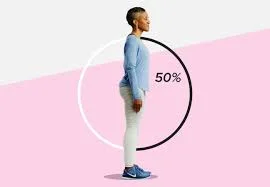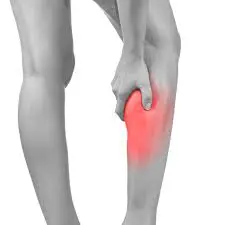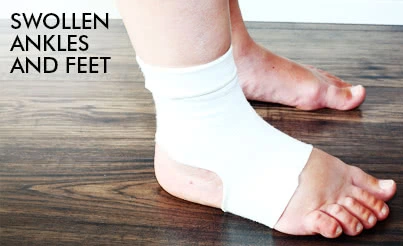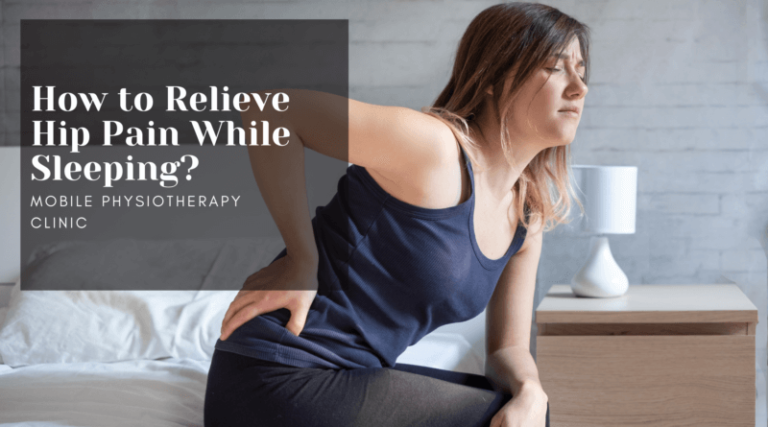How To Get a Better Posture?
Maintaining good posture is essential for overall well-being and can positively impact various aspects of your health. Whether you spend long hours working at a desk, engage in regular physical activities, or simply go about your daily routine, adopting a proper posture can contribute to increased energy levels, reduced muscle strain, and improved confidence.
What is posture?
Posture means how you hold your body. There are two types.
- Dynamic posture refers to how you hold yourself when moving, such as when you walk, run, or bend over to pick up something.
- Static posture refers to how you hold yourself when you are not moving, such as sitting, standing, or sleeping.
You should maintain an appropriate dynamic and static posture.
Your spine’s position is the key to excellent posture. Your spine has three natural curves: the neck, the middle back, and the lower back. Correct posture should keep these curves and not exaggerate them. Your head should be over your shoulders, and the top of your shoulder should be above your hips.
What is good posture?
Posture refers to how you sit or stand. Good posture balances the body and makes sure your weight is equally distributed. This indicates that the skeleton, muscles, and ligaments are not overstretched or strained.
- Maintaining proper posture requires three curves in your spine. It also keeps the muscles on both sides of the spine strong and balanced. It helps back pain and may increase your mobility and reduce discomfort.
- You can maintain proper posture while sitting or standing.
- Good standing posture does not indicate stiffness or rigidity. Your posture should be loose and flexible.
Back straight
- Position yourself as follows: head up, chin in, staring straight ahead, shoulders relaxed, tummy in, weight evenly distributed on both feet, knees straight.
- Place your back against the chair’s back while seated. Your knees should be at a straight angle, with your feet on the floor. Avoid crossing your legs.
Good posture can help prevent discomfort like muscle, back, and neck pain.
The way your body holds itself against gravity is called posture. Maintaining proper posture involves positioning your body to place the least amount of strain and stress on your joints and muscles. It should not feel forced or stiff, but rather organic and comfortable.
The following are some important elements of proper posture:
You should have a straight line through your shoulders, hips, and ears.
You should tuck your chin in just a little bit.
Instead of hunching forward, your shoulders should be loose and downward.
You should be using your core muscles.
Instead of locking your knees, slightly bend them.
What causes bad posture?
Problems with posture can also result from disorders that impair one or more of the body’s supporting components. These structures include yours.
- Neck and shoulders.
- Spinal column,
- Hips
- Back muscles, and abdominal wall.
Some people are born with genetic abnormalities that alter the curves of their spines and hips. This can affect posture from birth. Such situations can be handled to reduce the long-term adverse effect on posture.
In some circumstances, injuries from sports or other activities might change your posture as the bodyguards themselves from further injury, such as limping after a foot injury.
Our posture frequently changes as a result of our work or other activities that cause misuse of various body parts.
Underuse might potentially cause problems. For example, weak back muscles on either side of the spine may restrict our ability to maintain proper posture. The same is true for the abdominal wall muscles in the front of our bodies.
For many people, sitting for many hours each day year after year causes muscles and ligaments to tighten or weaken. This might also cause improper posture.
- Soreness in the shoulders, back, and neck
- Headaches
- Fatigue
- digestive issues
- breathing difficulties
How does posture affect my health?
Poor posture can harm your health. Slouching or slumping over can
- Misalign the musculoskeletal system.
- Wearing away at your spine makes it harder to protect and more prone to damage.
- Cause neck, shoulder, and back pain.
- Reduce your flexibility.
- Affects the way your joints move.
- Affects your equilibrium and raises your chances of falling.
- Make it difficult to digest your food
- Make it difficult to breathe
How can I improve my posture in general?
- Be careful of your posture during typical tasks, such as watching television, doing dishes, or walking.
- Stay active. Any sort of exercise can help you improve your posture, but some exercises are particularly beneficial. They include yoga, tai chi, and other classes that promote bodily awareness. It’s also a good idea to get started with core-strengthening exercises.
- Maintain a healthy body weight. Extra weight can weaken your abdominal muscles, cause difficulties with your pelvis and spine, and aggravate low back discomfort. All of these can aggravate your posture.
- Wear comfy, low-heeled shoes. High heels, for example, can disrupt your balance and cause you to walk differently. This puts more stress on your muscles and affects your posture.
- Make sure work surfaces are at a comfortable height for you, whether you’re sitting in front of a computer, preparing supper, or eating.
How can I improve my posture when sitting?
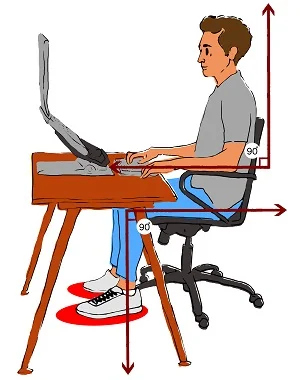
Many people spend much of their time sitting, whether at work, school, or home. It is important to sit properly and take frequent pauses.
- Switch seating postures frequently. Sitting requires adjusting your legs and maintaining flat feet.
- Now and again, gently stretch your muscles to assist in reducing muscle tension. Face forward with your feet flat on the ground.
- Don’t cross your legs; keep your feet on the floor, and ankles in front of your knees.
- Make sure that your feet touch the ground, or if that is not possible, use a footrest.
- Relax your shoulders; they shouldn’t be rounded or dragged backward.
- Keep your elbows close to your body. They should be bent 90-120 degrees.
- Make sure your back is well supported. If your chair has a backrest that can support the curve of your lower back, use a back cushion or another form of back support. Verify that your hands are pointing downward.
- Make that your thighs and hips are supported. You should sit on a well-padded seat, with your thighs and hips parallel to the floor. Once you feel the weight equally distributed across each of your palms, adjust your posture. This is the best sitting position for you.
To help you keep proper posture, look for a chair that offers support. Choose a chair that is ergonomically made to support every part of your back, including the curve at the bottom. Additionally, confirm that the design fits your weight and height.
If you are unable to purchase a new ergonomic chair, consider using a little pillow in the small of your back to support your lumbar region.
To improve your posture, adjust the computer monitor. When using a computer in an office setting, tilt the monitor slightly upward to make you sit up. Don’t raise it to the point where you have to jut out your chin to see it, though
How can I improve my posture when standing?
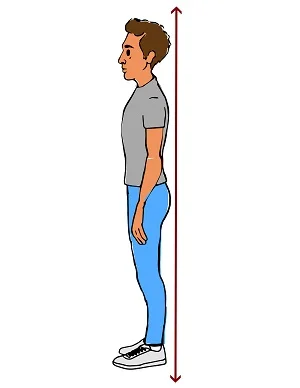
- Stand up straight and tall.
- Keep your shoulders back.
- Pull your stomach in.
- Keep your head level.
- Keep your feet about shoulder-width apart.
General methods for improving your posture
- Exercise regularly — even 30 minutes of low-impact exercise every day helps maintain your body flexible and active. This will help your overall health.
- Gentle workouts like yoga and Pilates can help strengthen the support muscles in your back and stomach. Concentrate on strengthening your core muscles (torso and pelvis).
- Spend 10 minutes per day performing simple stretching exercises to improve your posture.
- Stand tall. This involves straightening your spine, lowering your shoulders to their natural resting posture, and gradually contracting your stomach muscles.
- Perform small head movements to help relax stiff neck muscles that can interfere with healthy posture. Try gently moving your head in small circles, front to back, and side to side.
- Lie flat on the ground for two to three minutes every day. Relax and perform this exercise without the use of pillows or support. This will allow your body to return to its natural resting position and correct your posture.
- Wear flat, well-fitting shoes for more even weight distribution.
How to Improve Your Posture at Home
- When seated, avoid crossing your legs because this might cause overstretching of one side of your leg muscles. This can alter the posture of your spine over time, especially if you always cross your legs in the same way.
- Don’t sit for too long on low-seat sofas or excessively soft chairs.
- When sleeping, try to use one firm support pillow. This can help prevent neck pain from developing. It’s better to lie on your side, knees bent.
- Carry heavy items with caution, such as book bags, computer equipment, or shopping carts. Make sure the weight of your luggage is distributed properly on both sides of your body. A rucksack distributes weight equally on your shoulders.
- If you are a carer who spends a lot of time lifting, pushing, or carrying the person you care for, be careful to maintain your posture. Perform such bodily exercises correctly.
How to Improve Your Posture at Work

- When sitting, maintain your back straight and your feet flat on the ground. Try to maintain your knees and hips level. You might need a footrest to keep your hips and knees level. If you sit for a long time, you should rest your lower back against the back of your chair. This can be performed using a little rolled-up towel or a commercial product.
- Avoid sitting in a lowered position for extended periods, such as when working on a laptop or desktop computer. Make sure to get up and move about at regular intervals to change your body posture.
- If the job you have requires a lot of repetitive duties, as well as lifting and bending, ask your employer about training on how to lift and carry large, bulky, or awkward goods correctly.
- If you spend a lot of time on the phone, you risk developing phone strain. Resting a phone on your shoulder can cause your neck to twist while it remains in place. You may find that a headset is more comfortable.
How to improve your posture when driving
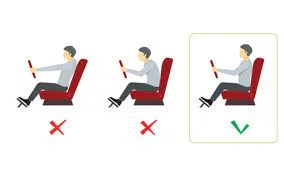
- Make sure your car seat and headrest are properly positioned to help with safe and comfortable driving.
- The steering wheel should be adjusted so that it is level with your chest and not your face. Maintain a bent arm position with your thumbs on the steering wheel rim. Position the seat upright to support your back and shoulders. Sit deep in the seat and support your body with your left foot. Try this to improve your posture while traveling.
- You may be able to improve or correct your posture over time by combining yoga, stretching, and spine-lengthening exercises.
- Having good posture is about more than just appearance. It promotes physical strength, flexibility, and balance. These may lead to less muscle soreness and increased energy throughout the day.
- Proper posture can also relieve tension in your muscles and ligaments, lowering your chances of injury.
- There might even be mental health benefits. suggests that upright posture can improve positive affect, decrease negative self-focus, and reduce fatigue in patients suffering from mild-to-moderate depression.
Physical therapist techniques
Some techniques to improve your posture, from a physical therapist.
You are surely aware by now that excellent posture is vital. In reality, improving your body posture can help you minimize tension, exhaustion, and pressure on your tendons, ligaments, and muscles.
Good posture is important for standing, sitting, and lying down.
Posture refers to the body’s alignment and position. Long-term “bad” posture, in which the spine and/or limbs are out of alignment, causes muscular and bone disorders due to gravity stress. Pain, discomfort, and stiffness will develop throughout your body over time, which might interfere with your regular activities.
As a physical therapist, posture is frequently the first thing I consider when evaluating someone.
Holding your body in a non-optimal position puts you at risk for strain and injury.
You can improve your posture with a few easy workouts.
The upper cross syndrome is the most prevalent sitting posture issue. The head is positioned forward in this arrangement. The shoulders are hunched up towards the ears, and the upper spine is rounded, curving outward at the upper back and shoulders.
Check your posture:
- Head back and tuck in your chin.
- Pinch your shoulder blades together on your back by lowering them.
- Lower back and leg pain may result from standing with lower cross syndrome. The pelvis is tilted forward and the lower back is arched in this position. Weak abdominal (stomach) and gluteal (butt) muscles result from this posture. The hip, calf, and thigh muscles could get extremely tight.
If you are unable to angle the monitor correctly, you might need to adjust your chair.
Your arms should be flexed, not straight out, so adjust your chair and posture accordingly. At the elbows, aim for an approximate angle of 75 to 90 degrees. You are too far back if they are too straight, and you are either slouching or sitting too close if they are more than 90 degrees.
When you spend a lot of time sitting down, take breaks to stand up. Every hour or so, even if you’re sitting with perfect posture, you should get up, stretch, and take a walk. It can be useful to simply take a few minutes to get out of your car and move around the room.
If you are the type of person who gets lost in your work, set an alarm to remind you to take a break.
Additionally, since your body needs to move throughout the day, these breaks are useful for your health.
Check your posture:
- Make sure your ankles are not locked in place by placing your knees over them.
- Maintain a neutral pelvic alignment.
- Reposition your shoulder blades and head back.
- Insufficient posture when lying down can also lead to muscle strain and back pain.
Check your posture:
- If you sleep on your side, place a thinner pillow under your head and a pillow between your knees.
- back sleeping, a cushion beneath your knees. Please ensure the average-sized pillow is under your head and not your shoulders when using it.
- Sleeping on your stomach can cause strain on your neck and back, so try to avoid it.
- Maintaining proper posture when getting in and out of bed is also crucial. To get into a sitting position, bend your knees, roll to your side, remove your legs from the bed’s edge, and use your arms to support yourself.
It’s important to stretch and strengthen your muscles for proper posture.
Tissues that have been kept in one position for an extended period and have become short or tight may benefit from stretching. On the other hand, strengthening includes consistently contracting the muscles, which contributes to their increased strength.
These exercises can all be combined to increase the effectiveness of the other: If you lack the flexibility to perform the necessary exercises, it can be challenging to strengthen your muscles; however, if you don’t stretch first, you’ll experience increased pain and tightness.
Several ways stretching your muscles can help your posture.
An imbalance where some muscles are long and weak and others are short and strong can be caused by tense muscles. It can hurt not just the muscles but also the joints and surrounding nerve tissue. Strain injuries are more common in people with tight muscles.
Stretching guidelines:
- As you extend the area, steady one end of it. To stretch your hamstring, for example, maintain your hip stable and simply extend your leg; to stretch your calf, maintain your heel in place and shift your body weight forward to feel the stretch.
- As you stretch, let your muscles relax.
- Verify your alignment.
- Repeat each stretch two or three times, holding it for 15 to 30 seconds each time.
- Remember to breathe!
Maintaining a proper posture requires strong muscles.
- To maintain good posture, you must include strengthening exercises in your daily routine. Weak muscles make it difficult to maintain good posture and increase the risk of injury to joints and other tissues. Muscle weakness can result from a variety of conditions, such as arthritis, neurological disorders, injury, immobility, and nerve entrapment.
- When performing strength-training exercises, pay particular attention to your shoulders, upper back, core, hips, and legs. Muscle fatigue should result from strengthening exercises, not soreness.
- Moving around a lot is one of the best ways to keep your posture in check.
posture is not good for too long a period.”Even with the greatest ergonomic setup, pain is inevitable if you spend ten hours a day at your desk. advises people to take a 15-minute posture check and get up and move around every 30 minutes or so.
Exercises For Posture Correction
Child’s Pose.
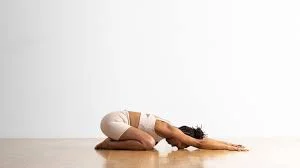
The child’s posture stretches and lengthens the spine, glutes, and hamstrings. It may also help relieve stress in your lower back and neck.
Do this pose:
- Sit on your shins, knees together, big toes touching, heels splayed to the side.
- Sink your hips back down to your feet. If your thighs do not go all the way down, place a pillow or folded blanket under them for support.
- Gently place your forehead on the ground or move your head to one side.
- Keep your arms extended or rest them against your body.
- Take deep breaths into the lower part of your rib cage and waist.
Relax in this position for up to 5 minutes, breathing deeply.
Forward fold (Uttanasana)
This standing stretch relieves stress in the spine, glutes, and hamstrings. It also stretches the hips and legs.
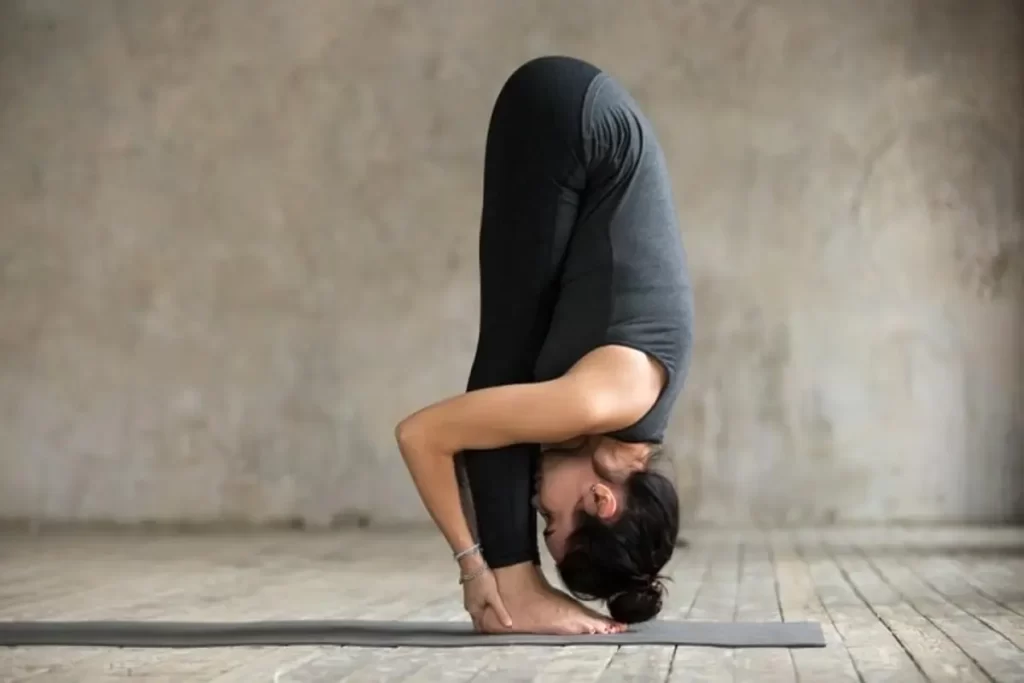
Do this pose:
- Stand with your big toes touching and your heels spread slightly apart.
- Fold forward after bringing your hands to your hips.
- Drop your hands to the ground or place them on a block. Don’t worry if your hands don’t contact the ground; simply go as far as you can.
- Bend your knees slightly, relax your hips, and let your spine lengthen.
- Tuck your chin into your chest and let your head fall heavily on the ground and 1 min hold.
Cat-Cow
position reduces chest, shoulders, and neck tension, improves blood circulation, and increases spinal mobility.
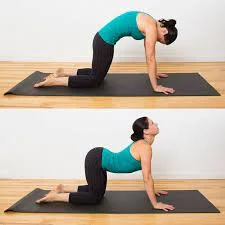
Do this pose:
- Come to your hands and knees, balancing your weight equally across all four points.
- Inhale to look up, dropping your abdomen down toward the earth while you stretch your spine.
- Exhale, arch your spine to the ceiling, and tuck your chin into your chest.
Standing Cat-Cow
This standing posture, which is a variant of the regular Cat-Cow, helps to relieve tightness in your back, hips, and glutes.
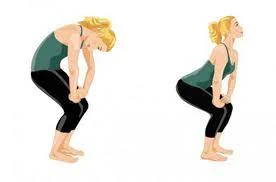
Do this pose:
- Stand hip-width separated and just flexed at the knees.
- Extend your hands in front of you or rest them on your thighs.
- Stretch your neck, bring your chin to your chest, and round your spine.
- Then look up, raise your chest, and move your spine in the other direction.
- Hold each posture for five breaths.
- Repeat this movement for a few minutes.
Chest opener
Opening and stretching your chest is especially beneficial if you spend most of your day sitting, as this causes your chest to move inward.

To perform this stretch:
- Stand with your feet approximately hip-width apart.
- Bring your arms behind you and interlace your fingers, palms pressing together. If your hands are too far apart, grasp a towel.
- Keep your head, neck, and spine in a single line while you look straight ahead.
- Inhale as you elevate your chest to the ceiling and place your hands on the floor.
- Take 5 deep breaths while holding this stance.
- Take a few deep breaths to relax.
- Repeat at least ten times.
High plank
High planks reduce pain and stiffness throughout your body while strengthening your shoulders, glutes, and hamstrings. They also help to increase core and back strength, which are both necessary for proper posture.
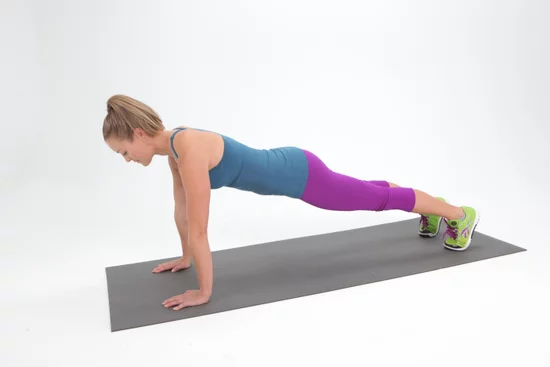
To perform this exercise:
- Get on all fours and straighten your legs, elevate your heels, and raise your hips.
- Straighten your back and work your abdominal, arm, and leg muscles.
- Stretch the back of your neck, soften your throat, and look down at the floor.
- Keep your chest wide and shoulders back.
Side plank
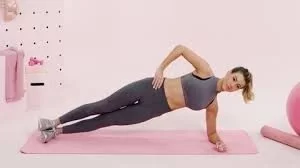
This variation on the classic plank targets the muscles in your sides and glutes.
To perform this exercise:
- From a high plank position, bring your right hand slightly into the center.
- Transfer your weight to your right hand, stack your ankles, and elevate your hips.
- For more support, drop your right knee to the floor.
- Maintain this stance by using your abs, side body, and glutes.
Downward-facing Dog
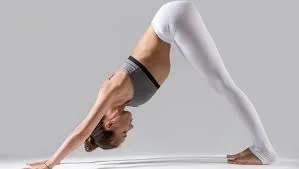
Downward-facing dog is a forward bend that can be performed as a resting pose to help balance the body. It can reduce back discomfort while also strengthening and straightening your back muscles.
Do this pose:
- Lying on your stomach, press onto your hands while tucking your toes under your feet and lifting your heels.
- Lift your knees and hips to elevate your sitting bones towards the ceiling.
- Bend your knees slightly to stretch your spine.
- Keep your ears straight with your upper arms, or tuck your chin completely into your chest.
- Press hard on your hands while keeping your heels slightly raised.
Pigeon pose
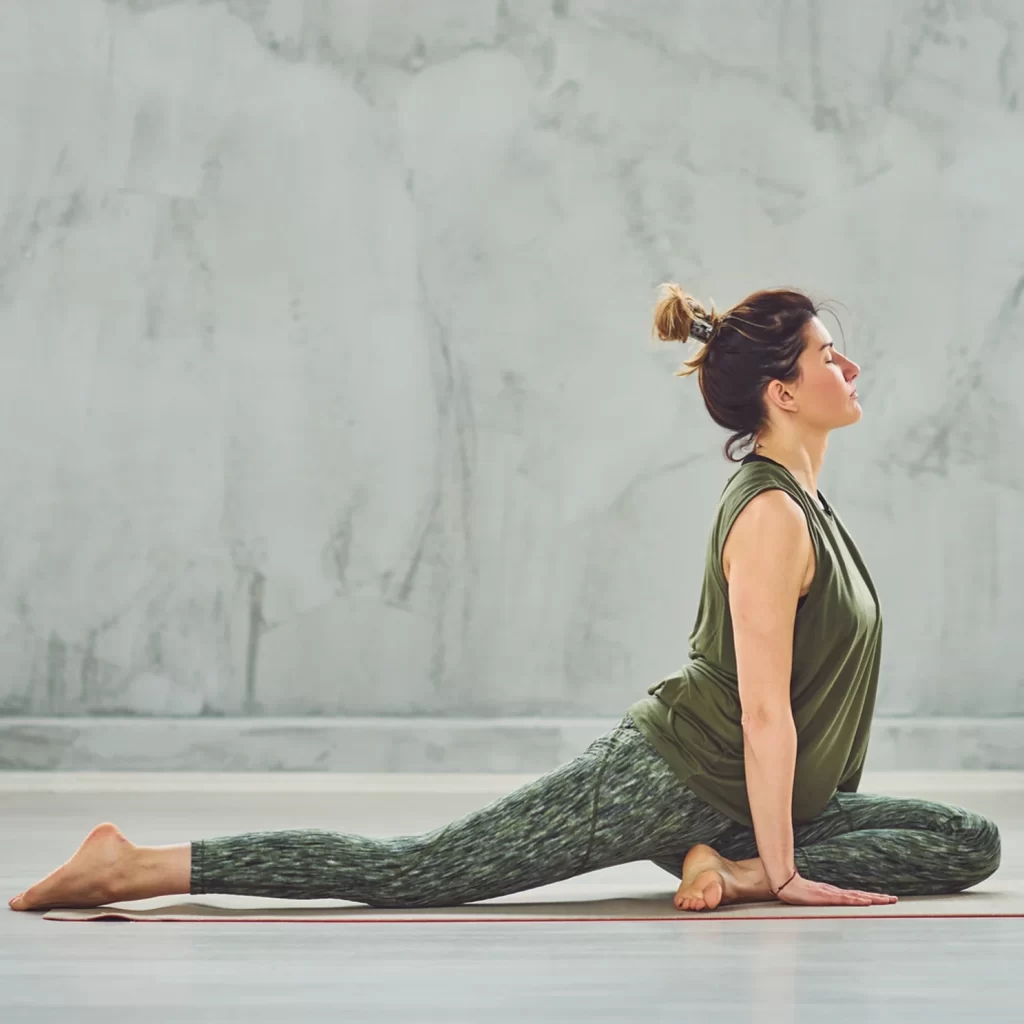
This hip-opening pose can also relax your spine, hamstrings, and glutes.
Do this pose:
- Come down on all fours, knees below hips and hands slightly in front of shoulders.
- Bend your right knee and position it behind your right wrist, with your right foot pointed to the left.
- Rest the outside of your right shin on the ground.
- Slide your left leg back, straighten your knees, and place your thigh on the floor.
- Make sure your left leg is extended straight back (not to the side).
- Slowly lower your torso to rest on your inner right thigh, arms extended in front of you.
- Slowly release the position by walking your hands back towards your hips and lowering your torso.
- Repeat on the opposite side.
Rotation of the thoracic spine.
Gently expanding the chest and rotating the spine reduces tightness while increasing stability and mobility.
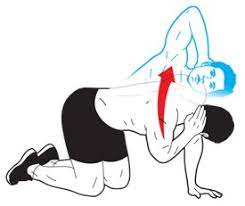
To perform this stretch:
- Come to all fours, drop your hips back to your heels, and rest on your shins.
- Place your right hand behind your head, elbow stretched to the side.
- Keep your left hand behind your shoulder, or raise it to the center and rest on your forearm.
- Exhale while rotating your right elbow up to the sky and stretching the front of your torso.
- Return to your original position by releasing.
- Repeat this exercise five to ten times, alternating sides.
Glute Bridge
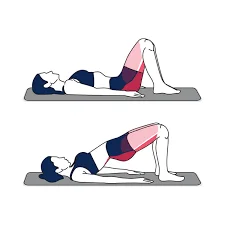
Glute bridges strengthen and stimulate the glutes while reducing lower back discomfort. This improves the function and alignment of your hips and pelvis, resulting in better posture.
To perform this exercise:
- Lie on your back, legs bent, feet about hip-distance apart.
- Keep your feet about one foot apart from your hips.
- Exhale as you raise your hips towards the ceiling and straighten your spine.
- 1 min hold it.
Isometric pulls.
Isometric pulls strengthen your shoulder, arm, and back muscles, allowing you to maintain proper posture.

To perform this exercise:
- Make a fist with each hand and stretch your arms in front of you, parallel to the floor.
- Exhale and bring your elbows back towards your shoulders, squeezing your shoulder blades together.
- Breathe deeply while holding this position for 10 seconds.
- On an inhale, gradually return to the beginning posture.
- Repeat the movement for one minute.
Arm circle
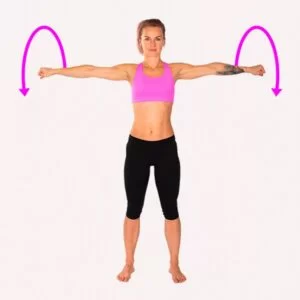
A step-by-step guide for performing arm circles.
Here’s the proper method to perform arm circles.
- Stand up straight, feet shoulder-width apart, hands out and parallel to the ground.
- Make small circles with your whole arm while keeping your back straight.
- Begin forming larger circles with your arm while keeping your movement regulated. As the circles grow larger, you should feel something in your triceps (the rear of your upper arm).
- Continue for 10-15 seconds before reversing direction.
- Remember to listen to your body. If you feel any pain, stop.
benefit
Arm circles can help strengthen the muscles in your shoulder and arm, namely the biceps and triceps. They also target your upper back muscles. Arm circles, when combined with other arm-specific activities, can help minimize fat development in your arms.
Neck roll
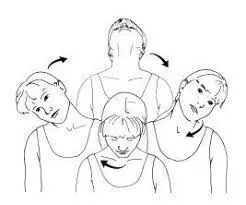
Primary muscles: Neck and cervical spine.
Secondary muscles: shoulders.
No equipment.
Neck Rolls Instructions:
- Start with your head straight and facing front.
- Gently tilt your head to the right and begin rolling it back.
- Continue rolling your head to the left and then downward.
- Return your head to its starting point and repeat in the opposite direction.
Exercise Benefits
The neck roll is a dynamic stretching exercise that releases and extends the neck muscles and cervical spine. This exercise can assist relieve any discomfort or stiffness caused by neck strain while also preventing neck injuries and pain.
Bird dog

How to Perform the Bird Dog Exercise.
- Find an area with enough space to stretch both arms and legs at the same time. Kneel on an exercise mat or other cushioned surface, keeping your knees hip-width apart and your hands firmly planted on the ground, about shoulder-width apart. Brace your abdominals.
- Point one arm straight out in front of you and extend the opposite leg behind you, creating a straight line from your extended hand to your extended foot. Keep your hips square to the ground. If your lower back begins to sag, elevate your leg as high as possible while keeping your back straight.
- Keep your core engaged throughout the exercise, and try to reduce any additional motion in your hips during the weight shift.
- Switch to the opposite side.
- Aim for five reps on each side, totaling ten. Add up to three sets of ten exercises. As an alternative, do a set of 10 bird dogs on one side and then switch to the other.
Benefits of Bird Dog Exercise
The primary aim of the bird dog is the erector spinae muscle. This long back muscle runs the length of the spine, connecting the skull, neck, and ribs to the vertebrae and sacrum of the hip. It controls the spine’s extension, flexion, and rotation.
Bird dog exercises specifically target two abdominal muscles: the rectus abdominis and the obliques. This motion also works the gluteus maximus muscle in the buttocks (while elevating the leg) as well as the trapezius and deltoid muscles in the upper back and shoulder.
Doorway pectoral stretch (flexibility)
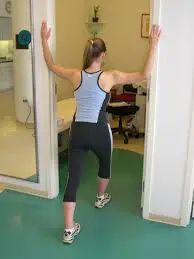
how to do it:
- Stand in the open doorway. Raise each arm to the side, bent at 90-degree angles, palms front. Rest your palms on the door frame. If this is too painful, try lowering your elbows slightly.
- Take a slow step forward with one foot. Do not lean forward; instead, stand erect.
- Hold for 15 seconds, or as directed. Take a step back and relax.
- Repeat three times or as recommended.
benefit
The doorway pec stretch expands the chest by extending the pec muscles. This stretch can assist in minimizing forward, rounded shoulders and hunched back postures, which can develop with time. Lengthening the pec muscles improves shoulder and neck mobility.
Foam roller chest stretch
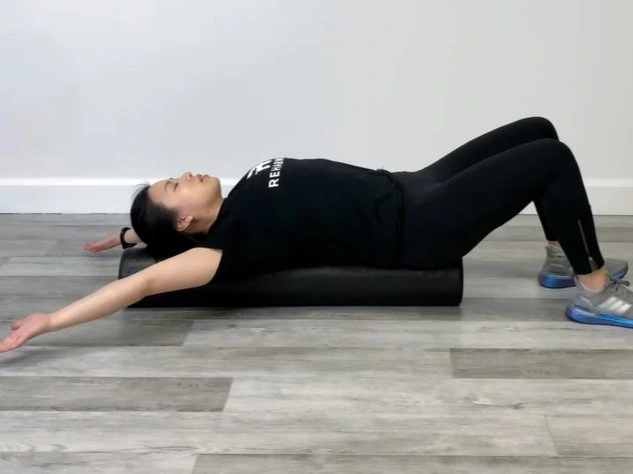
How to do it:
- Try this foam rolling chest exercise.
- Lie on the floor, stomach to the ground, and stretch your arms out on either side.
- Place the foam roller under one arm and tighten it against your body.
- Stretch the other arm out in front of you and place your hand firmly on the floor.
- Roll yourself up slightly onto the foam roller so that it rests comfortably on your pec muscle.
- Apply pressure and allow the vibrations to do their magic.
- You can gently move your body from side to side, but using a vibrating foam roller requires less muscular rolling.
Important Pointers for Best Posture
Don’t Be a Slouch
It causes increased stress on your spine. As a result, the bones, muscles, and joints that support your back become stressed. Poor posture, on the other hand, has effects outside the back. Your lungs and intestines have a more difficult time operating when you are in a continual slouch because it compresses your inside organs. This will eventually make it difficult for you to properly digest food or breathe.
Straighten Up
An excellent means of avoiding postural issues? Raise your head high. You’ll appear and feel better, even more looking good. To get an idea of your height, pretend that you are leaning against a wall. Your ears should cover the middle of your shoulders. Hold a straight knee, and tucked-in belly when standing. Keep your hips and booty hidden. Raise your head to the point where you feel like it is stretching towards the sky.
Never Give Up at Work
It’s comfortable to slump — maybe even to lean back and swivel a little. But that is not a suitable posture. Alternatively, try this: Fully break the chair. To keep your spine’s natural curve, insert a small, rolled-up towel or lumbar cushion behind your mid-back. Maintain a straight angle in your knee bending while keeping them at hip level or a little higher. Place both your feet flat on the ground.
‘Text Neck’: Take Care
Throughout the day, using your smartphone? Allow yourself a minute to extend your neck. When you tilt your head down to read texts, your spine becomes severely stretched. This can range from a single day to a whole year. Raise the phone so you can see better, and move your eyes rather than your head.
Avoid Being a Low Rider
Of course, relaxing back on a long drive feels good. However, it does not improve your posture. Consider sitting up more as an alternative. Avoid locking your legs. Your knees should be slightly bent. They ought to be slightly higher than the hip level.
Wear Shoes Only on Special Nights Out
They may be stylish, but their posture is probably not. Pumps and stilettos press the base of your spine forward, causing your back to overach. This can put pressure on nerves and change the alignment of your backbone, resulting in back pain. Furthermore, wearing extremely high heels causes knee discomfort. For daily wear, opt for a chunkier, lower heel.
Strike the Hay the Correct Way
A nap does not justify laziness. Don’t get the saggy, soft mattress. Select a firm one that maintains the natural curvature of your spine. Do you sleep on your side? Don’t hug your knees; instead, bend them slightly. Adjust a pillow so that your head and spine are parallel. Instead of using a thick pillow under their necks, back sleepers should use a small one.
Work Out and Tone Your Abs
Your back feels the strain more when you carry excess weight around your abdomen. To support your spine, you require strong muscles. A well-crafted exercise routine will maintain the optimal condition of your body and spine. And that’s important. Take up low-impact activities such as tai chi.
Check for Problems
You’re probably aware of your slouching posture. In case that’s the case, here’s a fast method to determine. Lean your head back against a wall. Step out from the baseboard by six inches. The wall is where your ass should be. The distance between it and your neck should be approximately 2 inches. If not, discuss posture correction techniques with your physician
Additional Tips
Being Aware:
- Body awareness: Observe how you carry your body during the day. Understand when your neck is being strained, slouched over, or hunched over.
- Checks for posture: Make notes to remind you to check and correct your posture throughout the day.
Identify your triggers: Pay attention to the things or circumstances that make your posture worse (e.g., sitting for extended periods, or using electronic devices).
Take Action:
- Ergonomics: Make sure your desk is arranged with the right chair height, back support, and monitor location.
- Stretching and strengthening: Make sure to regularly do exercises to strengthen your back and core muscles as well as stretches for tense muscles, particularly those in your neck, shoulders, and chest.
- Exercises for posture: Perform specific posture-enhancing exercises like chin tucks, scapular retractions, and wall angels.
- Keep a healthy weight: Being overweight can aggravate your posture, so it’s critical to keep a healthy weight.
- Wear comfortable shoes: Steer clear of high heels as they may cause alignment issues. Choose flat-heeled shoes that provide support.
- Mindfulness: Exercises that focus on the body, such as tai chi and yoga, can increase body awareness and make proper posture easier to maintain.
Some other tips
Take breaks: Get up and move around every 30 minutes if you are sitting for extended periods.
Change your sleeping position: Properly supported back or side sleep can help you achieve better posture.
Seek out expert assistance: See an occupational therapist or physical therapist if you struggle with chronic pain or maintain proper posture.
Risk Factors
Style of life:
- Sedentary behavior: Prolonged sitting, whether at a computer or in front of a screen, tightens and weakens the muscles in the shoulders and chest, which makes one slouch more easily.
- Repetitive motions: Certain sports, heavy lifting, and even bad typing habits can cause imbalances by putting strain on particular muscle groups.
- Poor sleep: Slouching and morning aches can be caused by sleeping in uncomfortable positions or on mattresses that aren’t right for your back.
- When you carry heavy bags, it can cause back strain and postural improper alignment if the weight is not distributed evenly, particularly on one shoulder.
Physical factors:
- Muscle imbalances: Bad posture can result from your body being out of alignment due to weak core muscles and tight, shortened muscles in your shoulders, chest, and neck.
- Skeletal differences: Spinal disorders such as scoliosis, kyphosis, and lordosis may affect posture and call for particular treatment approaches.
- Obesity or being overweight: Being overweight strains joints and muscles more, which makes maintaining proper posture more difficult.
Psychological factors:
- Stress and anxiety: Prolonged tension can cause rounded shoulders and slouching of the shoulders.
- Low self-esteem: As a means of diminishing oneself, a slumped posture can occasionally result from low self-esteem.
Age:
Naturally, flexibility declines with age, which can make it more difficult to maintain proper posture. Additionally, diseases like osteoporosis are capable of further damaging bones and muscles.
Complication
Muscle strain: Straining your muscles can result from pushing too hard or trying difficult posture corrections on your own without the right guidance, particularly if you have underlying imbalances or weaknesses. Don’t push yourself, start slowly, and pay attention to your body.
Joint pain: Aggressive adjustments or exercises can cause joint stress, just like they can cause muscle strain, especially if you already have joint problems like arthritis. Seek expert advice and adjust the exercises as necessary.
Overcorrection: Attempting to immediately attain a “perfect” posture can result in overcorrecting, which can cause further imbalances and discomfort. Strive for gradual improvement and concentrate on organic, long-term alignment.
Ignoring underlying conditions: Before beginning any posture improvement exercises, get advice from a healthcare provider if you have chronic pain, past injuries, or other medical conditions that may be affecting your posture. They can evaluate the circumstances and create an effective plan.
Ignoring other health-related factors: While posture is important, don’t overlook other factors like stress reduction, a balanced diet, and regular exercise. These enhance general health and can help maintain proper posture.
Impractical expectations: Recall that maintaining good posture requires patience and persistence. If you don’t find any results, don’t give up. Enjoy small achievements and concentrate on long-term development.
Impact on mental health: Anxiety or issues with body image can occasionally be exacerbated by an obsessive fixation on posture. Retain a balanced viewpoint and keep in mind that your general health and well-being are more than just your posture.
Precaution
Steps to Take When Correcting Your Posture:
You should take careful and mindful steps to improve your posture to prevent any negative effects on your health and well-being :
Avoid sudden changes:
Don’t try taking on a brand-new posture all at once. Your muscles and joints may become strained as a result, causing pain or even damage. Rather, make small changes and let your body adjust gradually.
Pay attention to your body.
Be mindful of any pain or discomfort you feel when you adjust or perform posture exercises. Before continuing, halt and seek medical advice from a professional if something feels off.
Don’t ignore underlying problems:
Before starting a program to improve your posture, speak with your doctor or physical therapist if you have any pre-existing injuries, chronic pain, or other medical conditions that may impact your posture. Based on your particular circumstances, they can safely and successfully guide you.
Avoid using fast fixes:
Look out for products or miracle cures that promise to improve your posture instantly. Customized methods and ongoing efforts are needed to bring about long-lasting change.
Continue to take a balanced stance:
Although having proper posture is important, try not to obsess over it. To prevent tense and stiff muscles throughout the day, always remember to unwind and move organically.
Seek expert advice:
See a physical therapist or occupational therapist if you have specific issues or queries about good posture techniques. They can offer you individualized tests, workouts, and advice to help you reach your objectives securely and effectively.
Conclusion
Good posture includes more than just getting up straight to look your best. It is an important part of your long-term health. Keeping your body in the proper position, whether moving or still, can help you avoid discomfort, injuries, and other health issues.
Good posture involves a combination of muscle strength, joint mobility, and general balance. Staying active, increasing body awareness, and wearing supportive shoes can all help.
If you spend a lot of time sitting, you may find it beneficial to redesign your workspace to be more ergonomic. Finding methods to include more movement, such as walking around the room at the top of the hour, may also prove beneficial.
FAQs
Is it possible to improve severely terrible posture?
Strengthening and stretching the muscles of the upper back, chest, and core is necessary for correcting poor posture. Scapula squeezes (squeezing your shoulder blades together for 30 seconds at a time) and rows (using a resistance band to draw back your elbows like you’re rowing) are two shoulder-strengthening exercises.
How can I improve my posture when standing?
How can I improve my posture when standing?
Stand straight and tall.
Keep your shoulders back.
Pull your stomach in.
Keep your head level. Keep your feet about shoulder-width apart
How long does it take to correct posture?
If you pay attention to your posture, you may correct it in a few weeks. The most important thing is to keep up with and maintain a workout routine. Neglecting your posture during the process will extend the time required to resolve the issue. Remember, improper posture is a habit; altering a pattern takes three to eight weeks.
Do postural braces work?
According to current research, back posture braces did not reduce pain when combined with education and exercise training.
Why can’t I sit properly?
Lack of ergonomic support When you stand, your body weight is equally distributed between your feet and legs, which can aid in maintaining good posture. However, while sitting, you may not have sufficient assistance for your back, hips, or legs, causing you to slouch or slump forward.
Can you correct years of poor posture?
You may be able to improve or correct your posture over time by combining yoga, stretching, and spine-lengthening exercises. Having good posture is about more than just appearance. It helps you improve strength, flexibility, and balance in your body.
What are the indicators of improper posture?
Symptoms can include rounded shoulders.
Potbelly.
Knees bent while standing or walking.
The head leans either forward or backward.
Back pain.
Body aches and pains.
Muscle fatigue.
Headache
How can I sit straight?
For the best sitting position, keep your feet flat on the floor or a footrest.
Avoid crossing your knees or ankles.
Maintain a tiny distance between the back of your knees and the chair.
Position the knees at the same or slightly lower height as the hips.
Positioning the ankles in front of the knees
Is it difficult at first to have good posture?
The first step towards better posture is acknowledging that it needs improvement. When you first try to sit or stand with proper posture, it will feel strange because you are not used to it. Your postural muscles may have weakened and fatigue easily, making it difficult to maintain a proper posture for lengthy periods.
Is poor posture a major deal?
Poor posture generates imbalances in the body, which we must then address. Some muscles stretch and weaken, while others shorten and tighten. Over time, our bodies are fatigued and worn down, resulting in pain. This suggests that your muscles and tendons aren’t operating at their best.
Can you correct years of poor posture?
There is room for progress, but expectations must be managed. Change will not occur overnight.
If you aren’t seeing results after a few weeks of consistent stretching and focused practice, speak with a healthcare expert. They may recommend x-rays to check the form and position of your spine.
What workouts reduce slouching?
Paying attention to how you sit and stand is the most effective technique to identify and correct slouching. Allowing your shoulders to relax and pull back slightly will assist prevent rounding or a hunched-over posture.
You might find it useful to think about an invisible cord slowly pulling your head toward the ceiling.
References
- Dpt, E. C. (2023, August 6). 4 Ways to Improve Your Posture – wikiHow. wikiHow. https://www.wikihow.com/Improve-Your-Posture\
- Common Spine Problems. (n.d.). WebMD. https://www.webmd.com/back-pain/ss/slideshow-spine-problems
- Ocs, A. D. P. D. (n.d.). 6 Ways to Improve Your Posture, from a Physical Therapist. Hospital for Special Surgery. https://www.hss.edu/article_improve-posture.asp
- Ocs, A. D. P. D. (n.d.). 6 Ways to Improve Your Posture, from a Physical Therapist. Hospital for Special Surgery. https://www.hss.edu/article_improve-posture.asp
- Guide to Good Posture. (n.d.). https://medlineplus.gov/guidetogoodposture.html
- How to improve your posture. (n.d.). Posture Exercises for Home and Work | Healthdirect. https://www.healthdirect.gov.au/how-to-improve-your-posture#:~:text=Try%20gently%20moving%20your%20head,and%20help%20correct%20your%20posture.
- Cronkleton, E. (2023, July 13). 12 Exercises to Improve Your Posture. Healthline. https://www.healthline.com/health/posture-exercises#takeaway
- Laverack, H. (2023, October 18). Chest Foam Roller Exercises: The Ultimate Guide to Recovery. Pulseroll. https://pulseroll.com/blogs/blog/chest-foam-roller
- Doorway Pectoral Stretch (Flexibility). (n.d.). Saint Luke’s Health System. https://www.saintlukeskc.org/health-library/doorway-pectoral-stretch-flexibility
- Rogers, P. (2022, May 3). How to Do the Bird Dog Exercise: Proper Form, Variations, and Common Mistakes. Verywell Fit. https://www.verywellfit.com/how-to-do-the-bird-dog-exercise-3498253
- How to Do Arm Circles | Step-by-Step | Stretching and Warmups Exercises | The Gym Group. (n.d.). https://www.thegymgroup.com/exercises/stretching-and-warmups-exercises/how-to-do-arm-circles/

